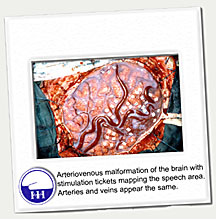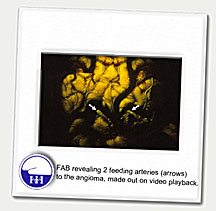|
5
|

|
arterial
anastomosis, injury of the cortex, selective venous occlusion
and the effects of carbon dioxide, prostaglandins, ethanol
and anti-histamines on vasospasm. It disclosed new dimensions
of information on the epicerebral circulation and in particular,
its microvascular component.Over
the decade from 1966 to 1976 with Lucas Yamamoto and others,
we published about 50 scientific articles co-authored with
Charlie and presented our results at many international
conferences.
|
|
Charlie
modified FAB for use in the operating room, where
it was combined with radio isotope blood flow studies
to provide many new observations on the microcirculation
of the human brain, such as
laminar flow in veins, the identity of shunting in
"red veins" and the "cerebral steal"
phenomenon, as well as changes in the blood-brain
barrier of tumours. But a unique value of the method
was to define precisely the arteries on the surface
of the brain that supplied large arteriovenous angiomas.
These could then be accurately occluded after which
repeat FABs could monitor
the degree of reduction in the flow through the angioma,
the completeness
of excision under controlled conditions and the preservation
of the blood supply to the adjacent cortex. Angiomas
bordering the mapped motor and speech areas, previously
rejected as inoperable, could thus be safely and completely
removed without producing neurological deficit.
|

|
|
|
In
the mid 1960s, we began to use double projection of FAB
slides to show the "before" and "after"
of experimental conditions, for example, to display the
area of ischemia after clipping a branch of the middle cerebral
artery or the effects on the microcirculation after a freezing
lesion that caused cerebral edema. Charlie often travelled
to meetings with Lucas Yamamoto and myself to demonstrate
this dual projection, since no one else was doing it at
that time. It proved such an advantage that we began to
use it for our lectures at the Neuro and it became widely
adopted by others. One of Charlie's lasting contributions
was to draw up audiovisual specifications for the Timmins
Amphitheatre of the Webster Pavilion, with its splendid
panoramic screen designed to show three or more full images
simultaneously.
|
| çPrevious
|
5
|
Next
è
|
|